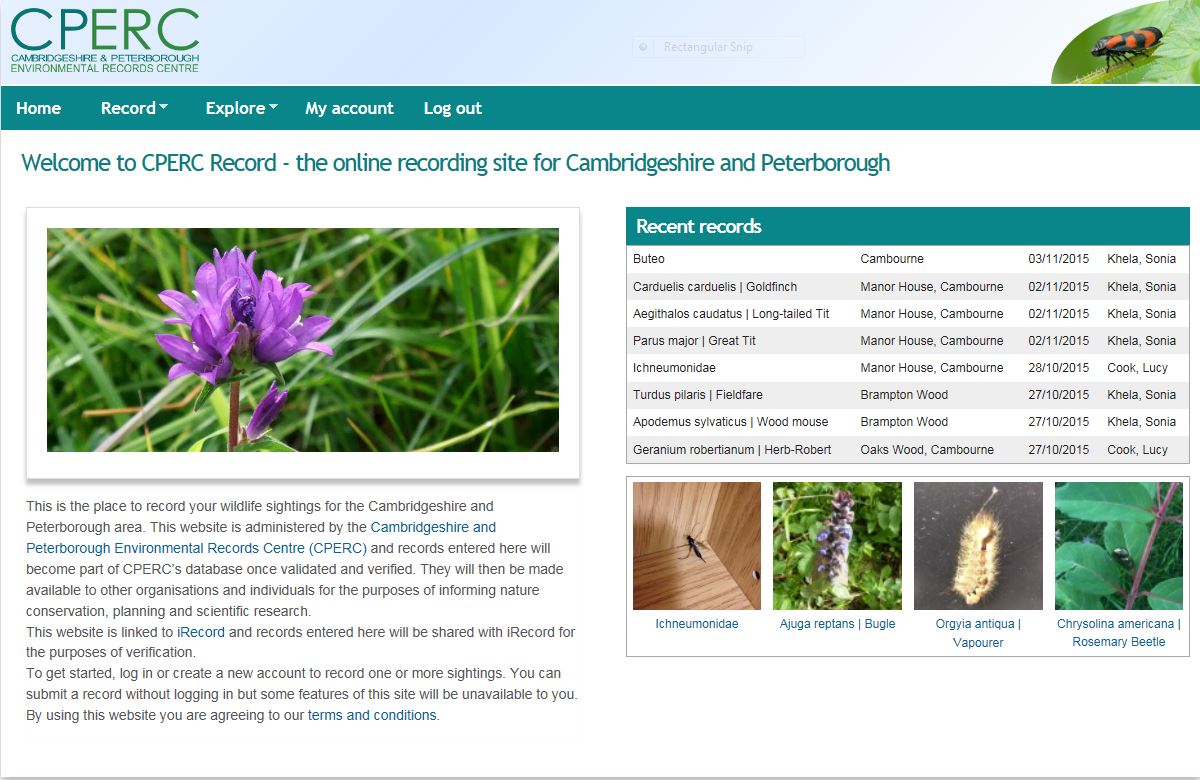EMAIL: data@cperc.org.uk CALL: 01954 713570

Amy Lewis
Latest news
Christmas and New Year Closure 2025/26
CPERC will be closed for the Christmas holidays from Wednesday 24th December and will reopen on Monday 5th January. All data requests must be confirmed on or before Friday 19th December in order for a guaranteed return before Christmas.
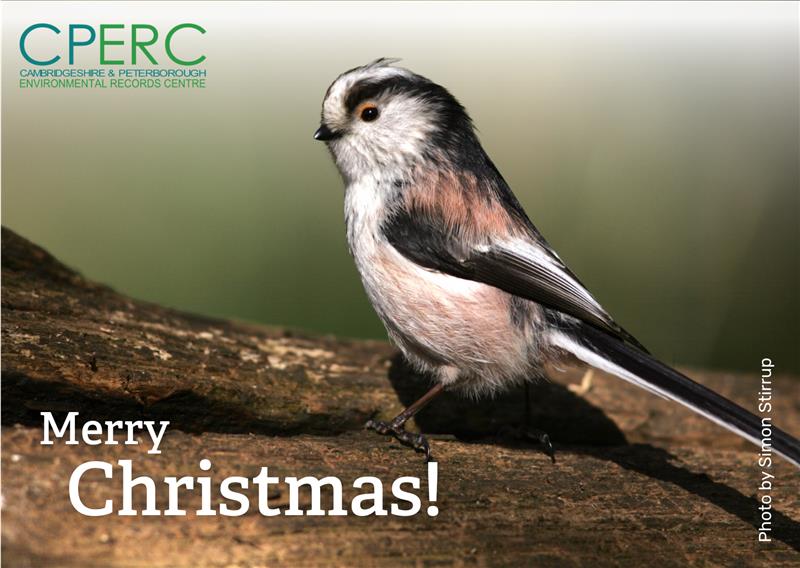
Colours of the Season
Caitlin Riley, October 2025
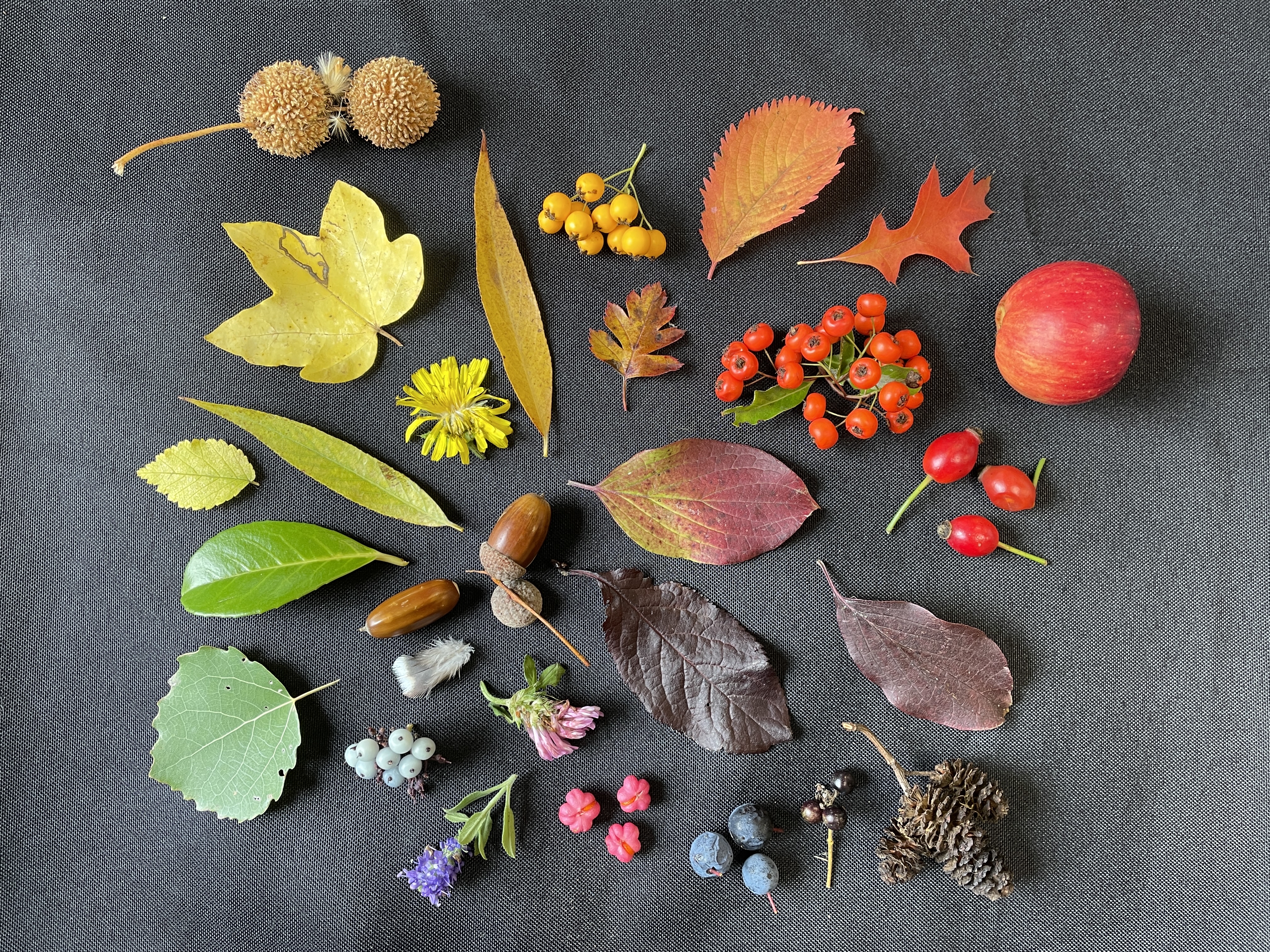
Autumnal display, Caitlin Riley
It’s tempting to think of autumn colours as just a blaze reds, oranges and yellows as the landscape swaps out its chlorophyll for a new anthocyanin pigmented wardrobe. But even just a half hour walk around your neighbourhood can reveal there's still a full rainbow to be found out there!
Of course, the oaks, hawthorns, and field maples impress with their fiery palettes but try looking out for the deep purples of the dogwoods or the glossy green laurels. Our willows are fading to pale greens and yellows while aspens boast their silver green leaves a little longer before donning their golden crowns.
This time of year also brings forth an abundance of interesting fruits, nuts, and seeds! Look out for glossy acorns and conkers, brilliant red rosehips, and dusky blue sloes. You might even be so lucky as to spot the hot pink of spindle berries or the baby blue berries of a Siberian dogwood!
So next time you’re out on a walk looking at the grey sky and red autumn leaves, take a moment so see what other colours of the rainbow you can spot.
Spider Season
Jo Wright, September 2025
It’s spider season, and according to a recent BBC News article, spiders have gone extra this year in terms of both size and numbers; the warm spring being the reason behind more of the nation’s (least?) favourite creepy crawlies appearing in your home.
A few of the prettier and more interesting versions of the taxa spotted by CPERC staff this month include the Wasp Spider and Four-spot Orb-Weaver (both spotted at Hobson’s Park, Cambridge), Green Crab-spider (Cambourne) and the Walnut Orb-Weaver (Brampton).
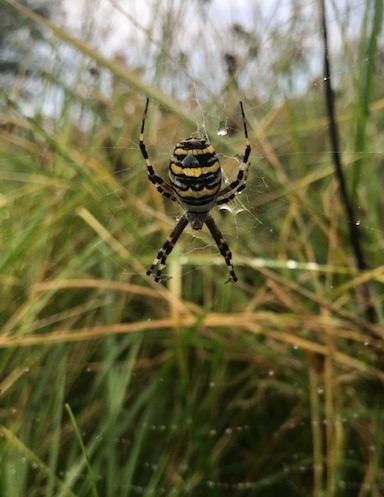
Wasp Spider, Louisa Carlisle
The Wasp Spider (Argiope bruennichi) is very distinctive and a great example of a mimic – in this case it mimics a wasp to keep it safe from predators. It’s probably originally from the Mediterranean and mainly found in the south of England but is slowly spreading north due to climate change. Related to the Common Garden Spider, they may look exotic and dangerous but are completely harmless.
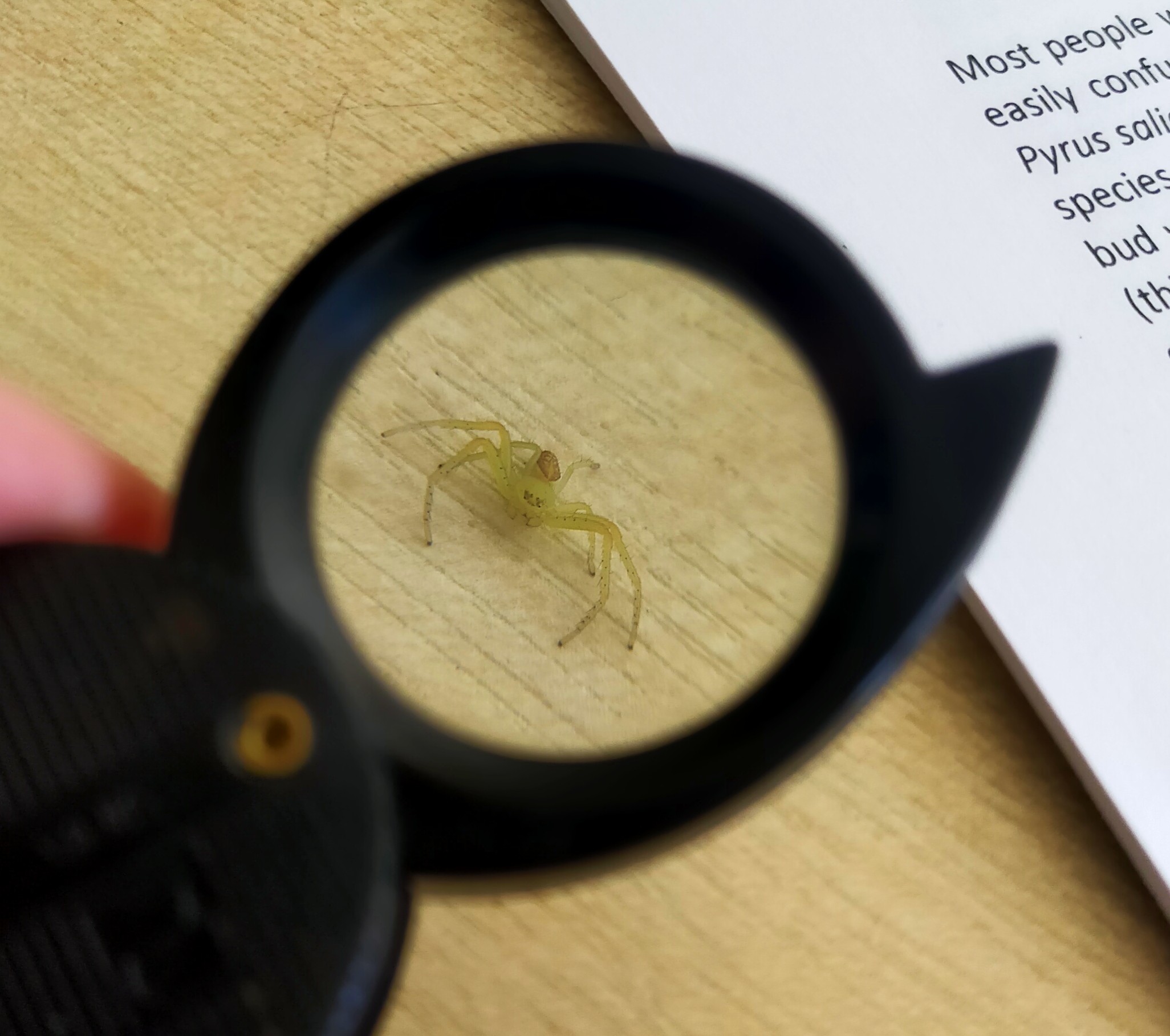
Green Crab-spider, Caitlin Riley
Dubbed ‘perhaps the prettiest of British spiders’ by our very own CEO, The Green Crab-spider (Diaea dorsata) is the smallest of our featured creatures, the females growing a maximum of 6mm. Mainly associated with woodlands, this spider can actually change colour over several days to fit its surroundings.
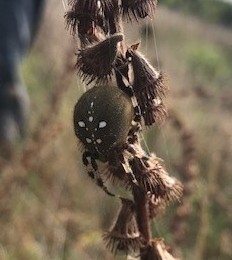
Four-spot Orb-Weaver, Louisa Carlisle
The Four-spot Orb-Weaver (Araneus quadratus) is, as the name suggests, distinguished by a distinctive pattern of four spots on its abdomen. It is found in vegeation strong enough to support it’s large web and it can vary a great deal in colour - the pattern can even change as the female spider becomes distended with eggs!
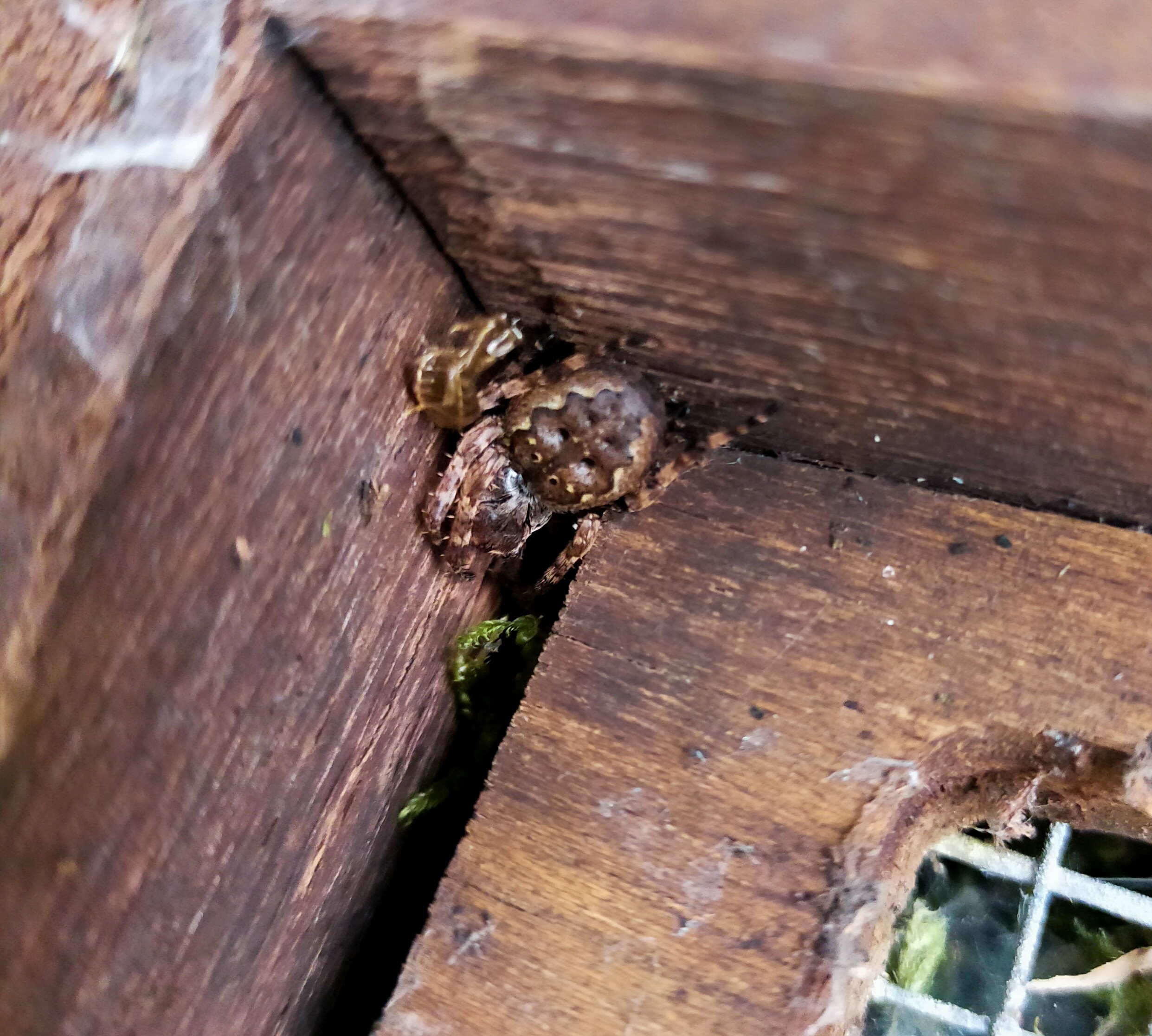
Walnut Orb-Weaver, Caitlin Riley
Finally, the Walnut Orb-Weaver (Nuctenea umbratical) is quite common and widespread across Britain. Its flattened body allows it to conceal itself under bark. In the 21st certury it also takes up residence in the cracks around door-frames, and this example was pictured hiding in a dormouse nest box!
If you find an interesting spider in your garden, out on a walk or anywhere in Cambridgeshire, please report it to us using our website!
CPERC is 20!
August 2025
The Cambridgeshire and Peterborough Environmental Records Centre (CPERC) was established as a not-for-profit organisation in 2005 with the help of funding from the Heritage Lottery Fund. Hosted by the Wildlife Trust BCN, it is the main source of biodiversity information for the whole of Cambridgeshire and Peterborough. Originally known as the Cambridgeshire and Peterborough Biological Records Centre, the name was changed in 2010 to better reflect the diversity of information it holds.
Over the last 20 years the database of species records has grown substantially and CPERC now holds over 2.5 million verified records, with tens of thousands of new records added every year.
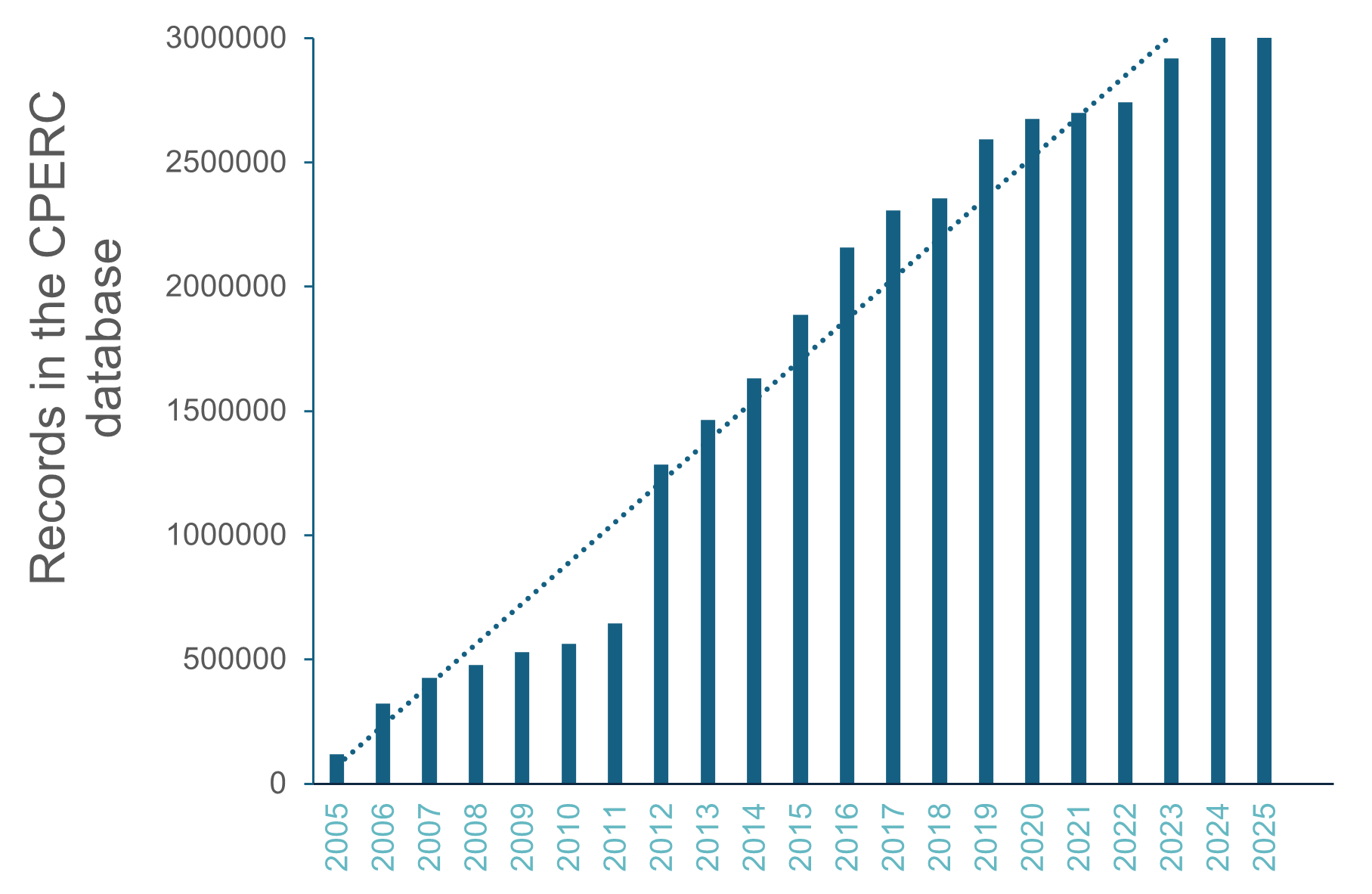
In addition to species data, CPERC hold information regarding designated sites, such as SSSI’s and Local Wildlife Sites, and also habitat information. The datasets are updated regularly, with a current project creating a new broad habitat map of the county being well underway.
Our data derives from a variety of sources, the vast majority coming from local volunteers and groups, with significant contributions also being made by the Wildlife Trust staff, ecological consultants, researchers and many others. Our most prolific recorder to date has been Hemiptera (true bugs) specialist Peter Kirby, with over 300,000 records submitted. We are always grateful to receive contributions and wildlife sightings can be reported via our website or email data@cperc.org.uk.
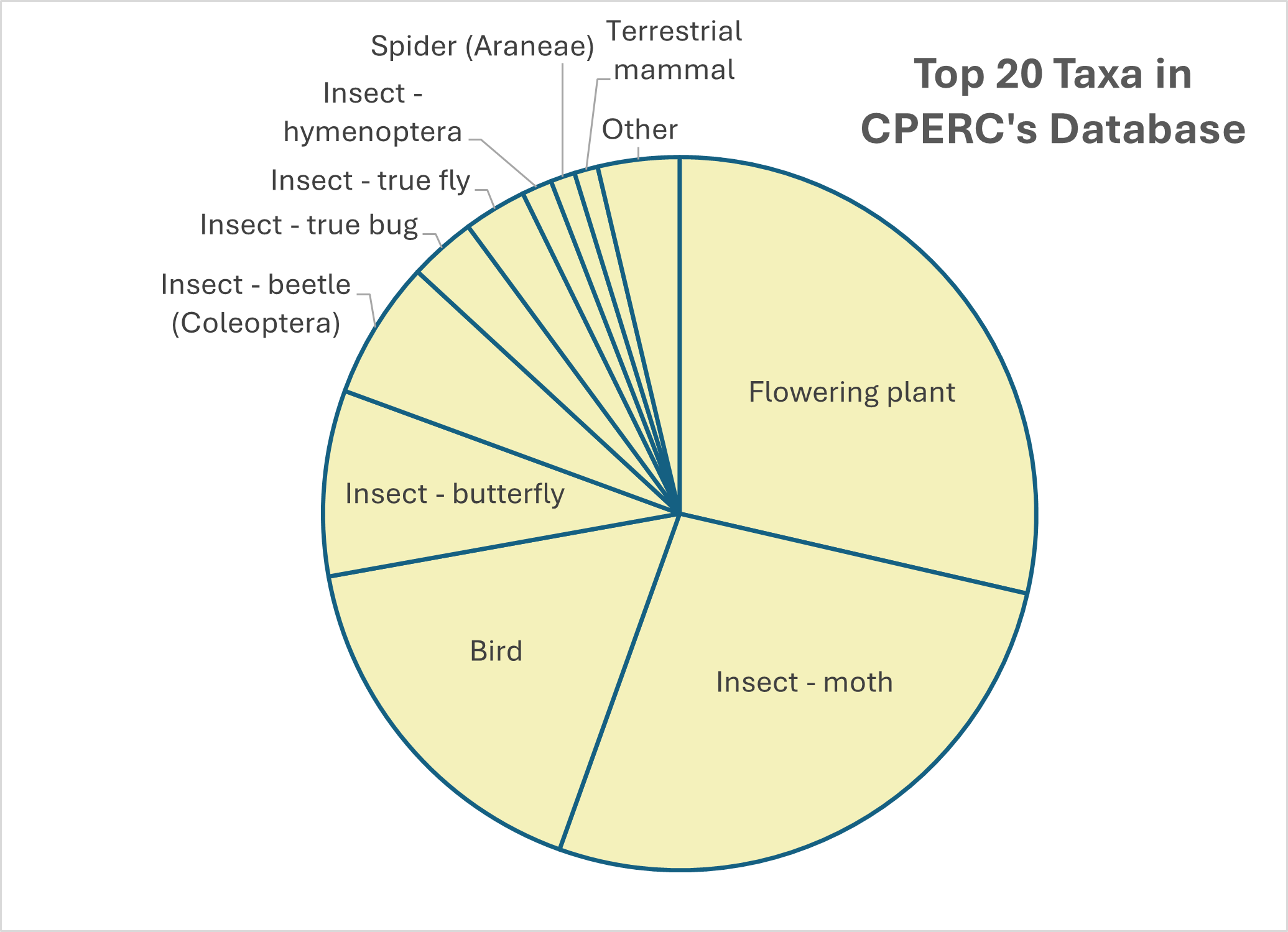
Data is shared with and used by a wide range of organisations and individuals, from local authorities and utility companies to ecologists, planners and researchers. In the early years, we answered around 30 commercial queries a year, and by 2024 this had risen to over 500. Our team has grown in tandem and there are now four permanent full-time members of staff and over the years we have hosted many volunteers. Cambridgeshire is one of the most nature depleted counties in the country and the commercial data requests and Partnership agreements continue to fund our vital work.
We would like to sincerely thank all those who have supported us over the years and who have generously given their funding, time and expertise. Contributing to CPERC’s growing datasets creates a valuable and powerful resource and allows others to study, monitor and conserve biodiversity across Cambridgeshire and Peterborough.
Recorder's BioBlitz at Southorpe Roughs SSSI
June 2025
CPERC were kindly given pemission by Natural England and the Walcot Estate to hold a Bioblitz at Southrope Roughs for it's expert recorders in June. Despite the temperature soaring well above 30 degrees, over 1000 species were recorded on the day.
CPERC Records on the NBN Atlas
September 2024
The majority of CPERC records are now available on the NBN Atlas! They are restricted to tetrad (2x2km) resolution maximum for public viewing but this means they can now be used to help show the distribution of species across different areas, especially when combined with data from other sources.
For more detailed information users will need to contact us directly.
Records we hold on our database which are thought to already be on the NBN Atlas from other sources have not been provided to avoid duplication.
See here NBN Atlas
Nature of Cambridge book is out now!
The Nature of Cambridge book, edited by Mark Hill, which is the culmination of the Cambridge Natural History Society ‘NatHisCam’ project is available now (published October 2022).
It gives a thorough introduction to the natural history of Cambridge, with sections covering different taxonomic groups and information about sites and habitats. CPERC contributed significantly to the ‘NatHisCam’ project by providing a data entry web page on our online recording website and providing records from our database for the Cambridge area. For more information see the link above.
Lizard orchids spreading in Cambridgeshire!
The rare lizard orchid, which in Cambridgeshire was previously just confined to Devils Dyke near Newmarket, has been reported in several new locations this year.
In June 2022 we had reports of lizard orchids in Sawston, Little Shelford and the south and eastern outskirts of Cambridge. If you have seen one please send us a photo with the date seen and the location details.
It is likely that the expansion in the range of these spectacular orchids in Cambridgeshire is just a small part of a wider expansion in the range across southern and eastern England.
Cambridgeshire Bat Group records
CPERC now has a new agreement with the Cambridgeshire Bat Group effective from 1st July 2022. The new agreement will mean that bat group records will be available in our data searches at full resolution for the first time. This means that those requesting species records will not have to contact the bat group separately for data searches for full resolution access to their records.
The Cambridgeshire Bat Group has been collecting records for decades and currently has 5000+ records which CPERC enquirers will now have access to. The information collected by the group has greatly increased our knowledge of bat species distributions and the locations of important roosting and hibernation sites. CPERC has worked closely with the bat group since we were established and we thank the bat group for their help and support over the years.
CPERC Newsletter 2020 is out now!
Our latest newsletter is available for download. It contains many articles updating readers about projects we have been focussing on over the past year and also other general news for those with an interest in the wildlife of Cambridgeshire and Peterborough.
The Habitats of Cambridgeshire
An exciting new report is available, detailing information from a new study into the habitats of Cambridgeshire. The work was carried out by Natural Capital Solutions and commissioned by the Cambridgeshire and Peterborough Biodiversity Partnership, and was a desk based study gathering together many sources of available digital information on the habitats of Cambridgeshire and Peterborough. CPERC's main contribution was providing the 1990s Phase 1 habitat data that we digitised into GIS from scanned maps over a number of years.
The report details the current status of known habitats in the area, and interestingly compares this with the information from surveys in the 1930s. Many maps are shown in the report detailing different aspects including potential habitat networks and opportunities.
CPERC Newsletter 2019 is out now!
Please see our latest newsletter for updates about our work over the previous year and related news. It can be downloaded here.
Henry Berman 1935 - 2017
Henry Berman, known to CPERC as a hymenoptera (mainly bumblebee) recorder recently passed away. He was known to many others as a former Biology teacher at St Ivo School. Henry sent many records on to CPERC since we started for which we are grateful. An obituary was written for the Huntingdonshire Fauna and Flora Society Annual Report and this can be downloaded here. Thank you to Barry Dickerson for this.
Orchards East
The Orchards East project, which CPERC is supporting and contributing to, has now launched in Cambridgeshire following the launch event at Girton College on 17th February 2018. Volunteers now wanted to help gather information on their local orchards!
The new Nature in Cambridgeshire is out now
The updated annual journal Nature in Cambridgeshire 2017 Volume 59 has been published in association with the Cambridge Natural History Society. Please visit www.natureincambridgeshire.org.uk for more details.
Cambridgeshire and Peterborough Additional Species of Interest (CPASI)
CPERC Standard Data Searches now include species on the Cambridgeshire and Peterborough Additional Species of Interest list, as approved by the Cambridgeshire and Peterborough Biodiversity Partnership in 2016. This list includes species which are not UKBAP priority species but are still considered to be species of nature conservation interest in Cambridgeshire and Peterborough, as suggested by local experts. As such, a more comprehensive set of species relevant to the local area is now searched for in our standard searches.
The CPASI list replaces the shorter list of former Local Biodiversity Action Plan (LBAP) species which were included in our Standard Data Searches.
CPERC Reaccreditation
We are delighted to announce that in November 2016 CPERC was reaccredited with ALERC, the Association of Local Environmental Record Centres, for a further 5 years. This involved reviewing and providing evidence of all our policies and procedures in order to fulfil the required criteria. CPERC was one of the first local records centres to be accredited in 2011.
Cheveley Parish Biodiversity Audit
The Cheveley Parish Biodiversity Group has produced its audit of the Parish. The report is a comprehensive review of historical environmental data and also details the activities undertaken to further understand the diversity of wildlife and habitats within Cheveley. The project generated a significant increase in number of records for the parish held on our database which now stands at 3600. The full report can be downloaded here.
Brampton Biodiversity Project update
The Brampton Biodiversity Project has identified 9 biodiversity hotspots in the parish based on surveys undertaken in 2013/14. These include the graveyard of Saint Mary Magdalene Church and London Anglers Association River Lane gravel pits. Read Pat Doody's full blog and find out more about these and other hotspots here.
CPERC Annual Report 2015 - 2016 is now available online.
Report highlights include the launch of our new online recording website, CPERC Record, the start of a countywide habitat mapping project and the celebration of our ten year anniversary. To download the report, click here.
Launch of CPERC Record
We are excited to announce the launch of CPERC Record our online recording site where you can submit all of your wildlife sightings in Cambridgeshire and Peterborough. The site enables you to enter one or multiple records and you can immediately view both your own records and other recorders' data either as a list or on an interactive map.
We hope you find the website easy to use and valuable for your natural history recording. To get started or to find out more about the site and how we use the data, please visit www.cperc-record.org.uk.
Cambridgeshire Mammal Atlas
This new atlas shows the distribution of wild mammals across the county recorded between 2004–2014, published by the Cambridgeshire Mammal Group. To buy contact the Mammal Group
The Larger Moths of Northamptonshire and the Soke of Peterborough
John and Brenda Ward’s review of the county’s moths is now available. To obtain a copy, please contact the authors. See this flyer for details.
Nature in Cambridgeshire 2015 now available
The updated annual journal Nature in Cambridgeshire 2015 Volume 57 has been published in association with the Cambridge Natural History Society. Please visit the Nature in Cambridgeshire website for more details.
CPERC Ten Year Anniversary
CPERC held an event on 2nd May 2015 to celebrate ten years since the official launch of the records centre. This involved of a series of talks by local recorders and experts and an opportunity to highlight CPERC's achievements. To find out more please view the Report below.
Ten Year Anniversary Event ReportTraditional Orchards survey report 2014
The updated report is now available on our Publications page.
CPERC reaches 1.5 million records!
In September 2014 our database reached 1.5 million records. CPERC would like to thank Data Recorders and members of public sending through their records and encourage you to continue doing so.
Nene Park Trust
We are extremely pleased to welcome the Nene Park Trust as a CPERC's newest wildlife partner. As part of our service level agreement we will be managing and processing their data, providing GIS training and assistance with online recording. The Trust will be setting up a series of recording days throughout the year so if you want to get involved, please visit the Nene Park Trustfor more details.
Please visit our Facebook page for all our latest news, events, announcements and updates.
